MENU
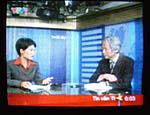
|
| FNCA 2005 Project Leaders Meeting |
FNCA 2005 Project Leaders Meeting for Public Information of Nuclear Energy
(Tokyo and Hachinohe City, Japan)
|
The FNCA 2005 Project Leaders Meeting (PLM) for Public Information (PI) of Nuclear Energy was held from September 12 to 15, 2005 in Tokyo and Hachinohe City, Japan.
The Ministry of Education, Culture, Sports, Science and Technology (MEXT) of Japan hosted the Meeting in cooperation with the Japan Atomic Industrial Forum, Inc. (JAIF).
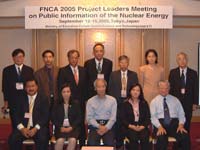 There were eight regular participants throughout the four-day meeting: namely, Representative of China, Project Leaders (PL) of Indonesia, Japan, Malaysia, The Philippines, Thailand and Viet Nam. The FNCA Coordinator of Japan and seven observers from Japan also attended the meeting. The Project Leader of Australia and Korea were unable to attend. There were eight regular participants throughout the four-day meeting: namely, Representative of China, Project Leaders (PL) of Indonesia, Japan, Malaysia, The Philippines, Thailand and Viet Nam. The FNCA Coordinator of Japan and seven observers from Japan also attended the meeting. The Project Leader of Australia and Korea were unable to attend.
-Paticipants of FNCA2005 Project Leaders meeting on Public Information (Photo)
On the first day (Sep. 12), during the Opening Session held at Shiba-Park Hotel in Tokyo, Dr. Yasumasa TANAKA, FNCA PI PL of Japan, Professor Emeritus, Gakushuin University delivered a welcome address. The Meeting was officially opened by Ms. Takiko SANO, Director for International Nuclear Cooperation, Atomic Energy Division, Research and Development Bureau of MEXT, Japan. Dr. Sueo MACHI, FNCA Coordinator of Japan, Commissioner, Japan Atomic Energy Commission made a speech and presentation of “FNCA Activities in FY 2004” and “Review and Plan of PI Project”.
Following the Opening Session, a presentation of the country report was made by each of the seven FNCA Public Information Project Leaders except for China and Japan.
On the second day (Sep.13) and the third day (Sep.14), sessions were conducted extensively to discuss some of the topics covered by the country reports and those relevant to the strategy and the action plans for the next 3-year period. The topics are:
(1) Strategy and technique of public information;
(2) Promotion of public information for RI and radiation application;
(3) Public information by FNCA Website and Newsletter;
(4) Effective communications with the mass media personnel; and
(5) Action plans for 3-year 2005-2007
The concluding session in Tokyo was held on September 14. The closing remark was delivered by Dr. Yasumasa TANAKA.
Special FNCA Session entitled “The Forum for Nuclear Cooperation in Asia (FNCA) and Nuclear Communications”
On September 15, a Special FNCA Session entitled “The Forum for Nuclear Cooperation in Asia (FNCA) and Nuclear Communications” was held at the University of Hachinohe Institute of Technology, the Aomori Prefecture, Japan, in conjunction with the Fall Meeting of the Atomic Energy Society of Japan (AESJ).
- Program and Introduction of PL (PDF1)
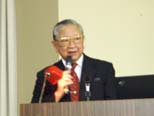 Dr. Yasumasa TANAKA, FNCA PI Project Leader of Japan, chaired the Special Session, and presented details of the FNCA. Dr. Yasumasa TANAKA, FNCA PI Project Leader of Japan, chaired the Special Session, and presented details of the FNCA.
- Details of the FNCA (Japanese version)(PDF2)
- Dr. Yasumasa TANAKA (Photo)
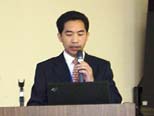 Mr. CHEN Gang, the representative of China, made a presentation entitled “Promoting Nuclear Power Construction in China”. Mr. CHEN Gang, the representative of China, made a presentation entitled “Promoting Nuclear Power Construction in China”.
- “Promoting Nuclear Power Construction in China” (PDF3-1)
- “Promoting Nuclear Power Construction in China” (PDF3-2)
- Mr. CHEN Gang (Photo)
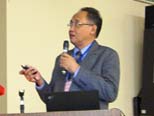 Mr. Adiwardojo, the PL of Indonesia, made a presentation entitled “Forum for Nuclear Cooperation of Asia (FNCA) Communication”. Mr. Adiwardojo, the PL of Indonesia, made a presentation entitled “Forum for Nuclear Cooperation of Asia (FNCA) Communication”.
- “Forum for Nuclear Cooperation of Asia (FNCA) Communication” (PDF4)
- Mr. Adiwardojo (Photo)
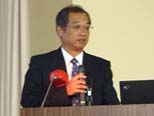 Mr. Minoru KUBO, the representative of Japan, made a presentation entitled “Report of FNCA PL Activity”. Mr. Minoru KUBO, the representative of Japan, made a presentation entitled “Report of FNCA PL Activity”.
- “Report of FNCA PL Activity” (PDF 5)
- Mr. Minoru KUBO (Photo)
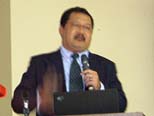 Mr. Mohd Rosli Muda, the PL of Malaysia, made a presentation entitled “Nuclear Science and Technology in Malaysia”. Mr. Mohd Rosli Muda, the PL of Malaysia, made a presentation entitled “Nuclear Science and Technology in Malaysia”.
- “Nuclear Science and Technology in Malaysia”
(PDF 6-1)
- “Nuclear Science and Technology in Malaysia”
(PDF 6-2)
- Mr. Mohd Rosli Muda (Photo 9)
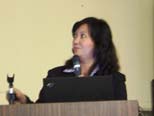 Ms. Rhodora R. Leonin, the PL of the Philippines, made a presentation entitled “Nuclear Energy Development, Recent Issues/ Concerns and Public Information Activities on Nuclear Energy in the Philippines”. Ms. Rhodora R. Leonin, the PL of the Philippines, made a presentation entitled “Nuclear Energy Development, Recent Issues/ Concerns and Public Information Activities on Nuclear Energy in the Philippines”.
"Nuclear Energy Development, Recent Issues/ Concerns and Public Information
Activities on Nuclear Energy in the Philippines Part 1"(PDF7-1)
"Nuclear Energy Development, Recent Issues/ Concerns and Public Information
Activities on Nuclear Energy in the Philippines Part 2"(PDF7-2)
- Ms. Rhodora R. Leonin (Photo)
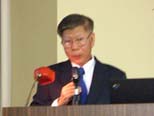 Mr. Vidhaya Rajatatibodee, the PL of Thailand, made a presentation entitled “The Utilization of Nuclear Energy in Thailand”. Mr. Vidhaya Rajatatibodee, the PL of Thailand, made a presentation entitled “The Utilization of Nuclear Energy in Thailand”.
- “The Utilization of Nuclear Energy in Thailand”
(PDF8)
- Mr. Vidhaya Rajatatibodee (Photo)
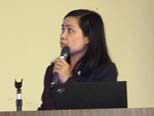 Ms. Dang Thi Hong, the PL of Viet Nam, made a presentation entitled “Country Report FNCA Public Information Project Leaders Meeting 2005”. Ms. Dang Thi Hong, the PL of Viet Nam, made a presentation entitled “Country Report FNCA Public Information Project Leaders Meeting 2005”.
- “Country Report FNCA Public Information Project Leaders Meeting 2005” (PDF9-1)
- “Country Report FNCA Public Information Project Leaders Meeting 2005” (PDF9-2)
- Ms. Dang Thi Hong (Photo)
Five Project Leaders representing Indonesia, Malaysia, the Philippines, Thailand and Viet Nam, and representative of China and Japan, presented their brief country report regarding the most important issues related to the peaceful uses of nuclear energy in their country. The forum was open to the public and attracted more than 80 participants.
| - Special FNCA Session(Photo)
|
|
|
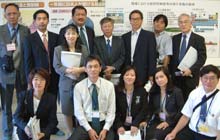 Technical tours to the “Institute for Environmental Science” and “Japan Nuclear Fuel Limited (JNFL)” at Rokkasho-Mura were also conducted on the same day. Technical tours to the “Institute for Environmental Science” and “Japan Nuclear Fuel Limited (JNFL)” at Rokkasho-Mura were also conducted on the same day.
- Technical Tours (Photo)
|
|
Minutes of the FNCA 2005 Project Leaders Meeting
on Public Information of Nuclear Energy
September 12 - 15, 2005
Tokyo and Hachinohe City, Japan
The FNCA 2005 Project Leaders Meeting (PLM) on Public Information (PI) of Nuclear Energy was held from September 12 to 15, 2005 in Tokyo and Hachinohe City, Japan.
The Ministry of Education, Culture, Sports, Science and Technology (MEXT) of Japan hosted the Meeting in cooperation with the Japan Atomic Industrial Forum, Inc. (JAIF).
On September 12, 2005, during the Opening Session held at Shiba-Park Hotel in Tokyo, Dr. Yasumasa TANAKA , Professor Emeritus, Gakushuin University of Japan, delivered a welcome address. The Meeting was officially opened by Ms. Takiko SANO, Director for International Nuclear Cooperation, Atomic Energy Division, Research and Development Bureau of MEXT, Japan. Dr. Sueo MACHI, FNCA Coordinator of Japan, Commissioner, Japan Atomic Energy Commission made a speech and presentation of "FNCA Activities in FY 2004" and "Review and Plan of PI Project". A reception on the evening of September 12 was sponsored by JAIF.
Following the Opening Session, a presentation of the country report was made by each of the seven FNCA Public Information Project Leaders except for China and Japan. The country report of China and Japan was presented by Mr. CHEN Gang and Mr. Minoru KUBO respectively . There were eight regular participants throughout the four-day m eeting : namely, Representative of China, Project Leaders (PL) of Indonesia, Japan, Malaysia, The Philippines, Thailand, Viet Nam and Mr. Minoru KUBO. The FNCA Coordinator of Japan and seven observers from Japan also attended the meeting. It was regretful that the Project Leaders of Australia and Korea were unable to attend. A list of overseas participants and the final program of the PL meeting are attached to the present minutes as Attachment 1 and Attachment 2.
| Themes and contents of the country reports: |
| |
(1) |
Recent topics of nuclear power and / or applications of radiation field as regards public information matters; |
| |
(2) |
The current state of affairs regarding public information activities in the FNCA member countries and plans for future action; |
| |
(3) |
FNCA activities; |
| |
(4) |
Using Regional S peakers B ureau; |
| |
(5) |
Training of nuclear c ommunicators; |
| |
(6) |
Communication with the mass media p ersonnel; |
| |
(7) |
Information networking among FNCA member countries, including an increased use of the FNCA website; |
| |
(8) |
Others. |
| On September 12 and 13, sessions were conducted extensively to discuss some of the topics covered by the country reports and those relevant to the strategy and the action plans for the next 3-year period. The topics are: |
| |
(1) |
Strategy and technique of public information; |
| |
(2) |
Promotion of public information for RI and radiation application; |
| |
(3) |
Public information by FNCA Website and Newsletter; |
| |
(4) |
Effective communications with the mass media personnel; and |
| |
(5) |
Action plans for 3-year 2005-2007 |
The concluding session in Tokyo was held on September 14. The closing remark was delivered by Dr. Yasumasa TANAKA.
On September 15, a Special FNCA Session entitled "The Forum for Nuclear Cooperation in Asia (FNCA) and Nuclear Communications" was held at the University of Hachinohe Institute of Technology, the Aomori Prefecture, Japan, in conjunction with the Fall Meeting of the Atomic Energy Society of Japan (AESJ). The Japanese Project Leader, Dr. TANAKA, chaired the Session. Six Project Leaders representing China, Indonesia, Malaysia, the Philippines, Thailand, Viet Nam and a Japanese deputy representative, Mr. KUBO, presented their brief country report regarding the most important issues related to the peaceful use s of nuclear energy in their country. The forum was open to the public and attracted more than 60 participants.
Technical tours to the "Institute for Environmental Science" and "Japan Nuclear Fuel Limited (JNFL)" at Rokkasho-mura were also conducted on the same day.
Themes and contents of the country reports:
Session 2: The Strategy and Technique of Public Information.
Co-Chai rs Dr. Yasumasa TANAKA (Japan), Ms. Dang Thi Hong (Viet Nam)
| Dr. TANAKA first introduced to the meeting two documents prepared by the FNCA Secretariat: |
| |
- |
3-year Action Plan on the FNCA Public Information of the Nuclear Energ y (PI) |
| |
- |
FNCA Project on Public Information (PI) o f Nuclear Energy - Strategy and Technique of Public Information. |
| |
The following agreement has been reached on the basis of discussions regarding the documents introduced by the Japanese Co-chair s . |
(1) The strategy of Public Information should be considered as three-fold.
Firstly, the strategy should involve two- way communications with the professional community as well as the general public regarding the safe and sustainable use of radiation and nuclear power.
Secondly, the strategy should involve the development and use of effective instruments of older and newer modes of communications, ranging from mouth to mouth interpersonal communications (e.g. RSB) to traditional mass media (e.g. TV, Radio, Newspapers, Newsletters) and new electronic media (e.g. E-mail, e-Newsletter, www and blog ).
Thirdly, the strategy also should involve publicity regarding FNCA to be addressed to government agencies, professional communities and the general public.
(2) Proposed action Plans
For FY2005
It was agreed that each PL should submit to JAIF new items to be included in the 3-year Action Plans by end of September, in accordance with a model form (a form of questionnaire) provided by the Secretariat. These proposed new items may constitute additions to those Action Plans that are already in operation within the FNCA's framework, such as Brochures, Newsletter, Website, RSB and the PI/PL meetings. It was also recommended that each member country should establish their own Public Information Strategy based on their socio-cultural setting and tradition. The FNCA Secretariat (JAIF) should act as the clearinghouse.
(3) During the course of discussions on various action plans, the following new proposals were made by Project Leaders and unanimously agreed.
| |
(a) |
Home Page of participating FNCA countries should have a standardized format in terms of the layout and the content, such as the institution/ organi zation profiles , the current news, the schedules of important events, and the links.
|
| |
(b) |
The institution/ organization profiles should include major nuclear- and radiation-related institutions and organizations of each country with the name, address, fax and telephone numbers , e-mail and web addresses and, if possible, history or backgrounds. Such information should be provided by each member country and sent to the FNCA Secretariat (JAIF) .
|
| |
(c) |
The Project Leader of Indonesia stated that the "Atomica", prepared by MEXT of Japan, has been found a very useful source of information regarding nuclear energy and radiation. It was suggested that the "Atomica" be translated into English for any English-speaking users to be able to have access to it.
|
| |
(d) |
It was suggested that FNCA " Blog " may prove a convenient tool of multi-directional and synchronic electronic communication because free "write-in" is possible at any time. The transmission of emergency messages and the sharing of quick questions and answers may also be made possible by using this new " Blog " method. |
For FY 2006
It was decided during the 2004 Project Leaders Meeting for Public Information of Nuclear Energ y in Bangkok, Thailand, that Indonesia will host the 2006 Project Leaders Meeting for Public Information of Nuclear Energ y .
For FY 2007
It was suggested at both the 2004 and the 2005 PI/PL meetings that Australia should host the 2006 PI/PL meeting. The FNCA Secretariat was requested to confirm at its earliest convenience if the Australian authority would accept the 2007 meeting to be held in Australia.
Finally, during the course of discussion regarding the Action Plans for the next three years, questions were raised regarding the status of t he proposed Questionnaire Survey on Energy and Environment which had been unanimously agreed to be included in the next 3-years project at the previous meeting in Thailand. The Japanese PL responded by saying that regretfully the proposed plan was given only a lower priority by MEXT for the next three-year period. He mentioned, however, that the results of the previous questionnaire survey had very much attracted the interest of FNCA Coordinators at the Coordinators Meeting held in Tokyo this spring.
Session 3: Promotion of Public Information for RI and Radiation Application in Each Country
Co-chairs: Mr. Mohd. Rosli Muda (Malaysia) and Ms. Dang Thi Hong (Viet Nam)
RI and Radiation Applications are among the most misunderstood technology in our time despite their importance in our daily lives. This situation brings us the challenge and the challenge to be more proactive in our public information program. In this regard the following PI activities were suggested by the participants.
| |
(1) |
Road show Program/ Nuclear Awareness Seminars in schools and universities. These activities involve the conduct of lectures on radiation, radiation safety, radiation applications; and organizing mini-exhibitions which include actual demonstration on how to measure radiation using a survey meter. Feedback mechanism (through the use of survey questionnaires) is also a component of the programs . |
| |
(2) |
Hiring a public relations company to promote RI and radiation applications has significantly enhanced the pub lic information activities of Thailand. |
| |
(3) |
Mobile exhibition is also an effective way of promoting radiation applications . |
| |
(4) |
Holding of nuclear-science quiz through the printed media and radio generates interest on radiation applications . |
| |
(5) |
Organizing specialized groups to help in the public information promotion activities. For example, in Japan, a 10-member ladies group called `Sweet Potato, Sugar and Apples` helps in educating high school students and other groups about radiation technology and nuclear energy development in Japan. In Malaysia, three specialized groups had been organized for exchange of information among members. These groups are the reactor interest group (RIG), floral interest group (FIG), and the biomaterial interest group (BIG). |
| |
(6) |
Providing actual products or samples produced by radiation technology. For example, Indonesia had provide samples of radiation-induced rice mutants to farmers and demonstrating the use of Renograph to the public for diagnoses of the kidney significantly helps in promoting acceptance of radiation technology. Traditional performances by local artists are also useful to explain the benefits of radiation technology to the public. |
| |
(7) |
Conduct of seminars for students involved in writing for their school newsletters are a good practice to disseminate nuclear information to the youth. |
| |
(8) |
Adopting a Student Program` prove to be an effective technique to create interest of nuclear technology into the society. For example, Malaysia had done such program in the past years, providing students with exposure to the activities/life of a nuclear scientist. |
| |
(9) |
Visit to nuclear facilities such as JNC, JAERI and nuclear power generating station provides is an effective way of educating various groups like social science university students to the beneficial applications of nuclear technology. Exhibitions also provide opportunities to educate the students as well as their parents who come with them to such events. |
Production of video documentaries significantly helps in enhancing public's knowledge of nuclear technology. Examples: video documentaries on uranium mining
Session 4: Public Information by FNCA Website and Newsletter
Co-chairs; Mr. Adiwardojo (Indonesia) and Mr. Vidhaya Rajatatibodee (Thailand)
Public Information by FNCA Website and Newsletter proved to be very useful and effective tools to reach as many people as possible. In order to sustain and maintain the effectiveness of FNCA Website and Newsletter, the meeting had underlined the proposals that should be considered by the member countries and the secretariat:
| |
(1) |
To keep continuation in utilizing the FNCA website and Newsletter based on demand driven. |
| |
(2) |
To u pdat e the information in timely manner. |
| |
(3) |
To provide the public with understandable and interesting information . |
| |
(4) |
Each FNCA member countries will assign a dedicated staff to manage the website. |
| The specific items to be considered for the website are as follows: |
| |
(1) |
The nuclear- and radiation-related institutions and organizations profile of FNCA member country will be introduced in FNCA website. |
| |
(2) |
The content of the FNCA website will includes: |
| |
a) |
Main menu: Introduction and Institution profile. |
| |
b) |
Specific menu: It will consist of: News, Publication, Linkage with others Agencies, and Additional items. |
| FNCA Newsletter Publication: |
| |
(1) |
To give a handy information to the public regarding FNCA activities. FNCA Newsletter will be prepared by the FNCA Secretariat in cooperation with the FNCA member states and will be distributed through the FNCA member countries. |
| |
(2) |
The secretariat will keep producing the FNCA Newsletter in PDF format through the website. |
Session 5: Effective Communication with Mass Media
Co-chairs: Mr. CHEN Gang (China) and Ms. Rhodora R. Leonin (The Philippines)
The participants from member Countries of FN CA shared their experiences on communication with mass media. The following comments and suggestions were raised by the Project Leaders.
| |
(1) |
Respecting the principles of "Fairness", "Truthfulness" and "Goodwill", communications with mass media should be conducted in a friendly and sincere manner with well-prepared background materials and good logistics.
|
| |
(2) |
Maintaining good personal relationship with both the working level and the senior-level media personnel helps facilitate connection with media. A good impression during the first contact can help the good relationship with media. It is of key importance to cope with first contact with mass media personnel. Easy access to telephone directory including cell phone numbers is good practice for communication with media. Routine and frequent gatherings or meetings with media in forms of press club, drinking bar, news room or whatever form, promote s linkage with mass media. Try to maximize the establishment and enhancement of good relationship with media. In whatever cases, do not make enemy with media personnel.
|
| |
(3) |
In view of deadlines of news and reports by media, advance notice of celebrations or news event is the basis for timely news coverage by media. To review draft of news or article and to give prompt feed back to media can improve the fairness and truthfulness of the reports by mass media.
|
| |
(4) |
Positive and timely response to the inquires or phone call of mass media is critical for effective linkage with mass media. To ensure the publishing or broadcasting of important items by mass media, timely contact with senior management level of the target media is necessary. New staff for public relation should be trained or instructed to work with mass media.
|
| |
(5) |
When bad news of an accident in nuclear facilities comes, rumors go parallel, even across the national boundaries. Informing the mass media of the updated status and relevant information is an effective way to cope with the rumors and to ease the concern of the public. In case of accidents or emergency, one authorized information source favorably by only one spokesman is emphasized for information release. |
Finally, all participants of the 2005 FNCA Public Information Project Leaders meeting expressed their appreciation to t he Ministry of Education, Culture, Sports, Science and Technology (MEXT) of Japan , and Japan Atomic Industrial Forum, Inc. (JAIF), for their cooperation and assistance in making th is meeting possible.
The m inutes were agreed upon by all the participants at the meeting and shall be reported in the Seventh FNCA Coordinators Meeting to be held i n Tokyo, Japan, in March 200 6.
|
|
Program of the FNCA 2005 Project Leaders Meeting
on Public Information (PI) of Nuclear Energy
September 12-15, 2005, Tokyo, Japan
| Place: |
Shiba Park Hotel
1-5-10 Shiba-Kouen, Minato-ku, Tokyo, Japan
TEL: +81-3-3433-4141, FAX: +81-3-3433-4142 |
| Organized by: |
Ministry of Education, Culture, Sports, Science and Technology
(MEXT), Japan |
| In Cooperation with: |
Japan Atomic Industrial Forum, Inc. (JAIF) |
| Tuesday, September 13, 2005 |
| 9:30-10:00 |
|
Registration |
| Opening Session |
| 10:00-11:00 |
|
MC: Prof. Dr. Nguyen Mong Sinh, VAEC |
| 10:00-10:05 |
|
Welcoming Address
People Committee of Lam Dong Province |
| 10:05-10:10 |
|
Opening Remarks
Ms. Miwako Shimizu
Special Staff, Atomic Energy Division,
Research and Development Bureau, Ministry of Education, Culture, Sports, Science and Technology of Japan (MEXT) |
| 10:10-10:15 |
|
Opening Address
Viet n am Atomic Energy Commission (VAEC) |
| 10:15-10:30 |
|
Introduction of Participants |
| 10:30-10:50 |
|
Commemorative Photograph
Coffee Break |
| 10.50-11:20 |
|
Report on the 6 th Coordinators Meeting and t he Scope of the HRD Workshop 2005
Mr. Hideo Matsuzuru, Project Leader (PL) of Japan |
| Presentation Session 1 - Country Report "Recent topics and Concept of ANU" |
| 11:20-17:55 |
|
Concept of ANU
(Viet Nam, China, Malaysia required to include HRD strategy models)
Chairperson: Ms. Rapieh Aminuddin |
| 11:20-12:05 |
|
Mr. Hideo Matsuzuru, PL of Japan |
| 12:05-13:30 |
|
Lunch
Chairperson: Ms. Rapieh Aminuddin |
| 13:30-14:30 |
|
Mr. Vu Dang Ninh, PL of Viet Nam |
| 14:30-15:05 |
|
Mr. Chen Gang, PL of China |
| 15:05-15:25 |
|
Coffee Break
Chairperson: Ms. Estelita Gregorio Cabalfin |
| 15:25-16:00 |
|
Mr. Karsono, PL of Indonesia |
| 16:00-16:35 |
|
Mr. Eui-Jin Lee, PL of Korea
C hairperson: Mr. C hen Gang
|
|
16:35-17:10 |
|
Ms. Rapieh Binti Aminuddin, PL of Malaysia |
| 17:10-17:35 |
|
Ms. Estelita Gregorio Cabalfin, Acting PL of The Philippines |
| 17:35-17:55 |
|
Thailand's Model of Human Resources Development Strategy
Dr. Somporn Chongkum, PL of Thailand |
| Wednesday, September 14, 2005 |
| 9:00-12:00 |
|
Technical tour
Nuclear Research Institute (Dalat)
Dalat University |
| 12:00-13:30 |
|
Lunch |
| Presentation Session 2 - HDR Network and System for degree |
| 13:30-14:45 |
|
Chairperson: Mr. Karsono |
| 13:30-13:45 |
|
Asian Network for Education in Nuclear Technology
Ms. Rapieh Aminuddin |
| 13:45-14:00 |
|
Present status of WNU and other International Networks
Ms. Keiko Hanamitsu, Japan Atomic Industrial Forum, INC. (JAIF) |
| 14:00-14:30 |
|
Support system in Japanese University for Foreign Students, Science and Engineering to earn Doctoral Degree
Dr. Takatoshi Takemoto, Tokyo Institute of Technology |
| 14:30-14:45 |
|
General Discussion |
| 14:55-15:05 |
|
Coffee Break |
| Discussion Session 1 - ANU Concept |
| 15:05-17:30 |
|
Chairperson: Mr. Eui-Jin LEE |
| 15:05-15:35 |
|
Summary o f the Survey on the ANU Concept
Dr. Nobuo Sasamoto, JAERI |
| 15:35-17:30 |
|
General Discussion |
Thursday, September 15, 2005
|
| Discussion Session 2 - ANU Concept and Future Plan |
| 10:00-17:30 |
|
Chairperson: Mr. Vu Dang Ninh & Mr. Hideo Matsuzuru |
| 10:00-11:00 |
|
Discussion on ANU Concept and Future Plan |
| 11:00-11:15 |
|
Coffee Break |
| 11:15-12:00 |
|
Lunch |
| 13:30-13:40 |
|
Briefing of the Discussion and Point for Mutual Agreement
Mr. Hideo Matsuzuru
Chairperson: Dr. Sueo Machi |
| 13:40-15:30 |
|
Drafting ANU Concept and Future Action Plan |
| 15:30-15:50 |
|
Coffee Break |
| 15:50-16:00 |
|
Commemorative Photograph |
| 16:00-17:30 |
|
Drafting ANU Concept & Future Action Plan (Cont'd) |
| Friday, September 16, 2005 |
| Secretariat Work - Tentative summary of WS |
| 9:00-12:00 |
|
Chairperson: Mr. Vu Dang Ninh & Mr. Hideo Matsuzuru |
| 9:00-12:00 |
|
Drafting of Minutes and of Reports to SOM |
| 12:00-13:30 |
|
Lunch |
| Conclusion Session - Summary of WS and Future Plan |
| 13:30-14:45 |
|
Chairperson: Mr. Vu Dang Ninh & Mr. Hideo Matsuzuru |
| 13:30-13:45 |
|
Future Plans of HDR Project
Ms. Keiko Hanamitsu |
| 13:45-14:45 |
|
Adoption of Minutes and of reports to SOM |
| 14:45-15:05 |
|
Departure from Japan |
| 14:45-14:50 |
|
Closing Session
MC: Prof. Dr. Nguyen Mong Sinh |
| 14:50-14:55 |
|
Mr. Hideo Matsuzuru |
| 14:55-15:00 |
|
Dr. Sueo Machi The FNCA Coordinator of JAPAN
Commissioner, Atomic Energy Commission of JAPAN (AEC) |
| 15:00-15:05 |
|
Prof. Dr. Nguyen Nhi Dien, Director, Nuclear Research Institute,
Vietnam Atomic Energy Commission |
|
|
List of Participants for FNCA 2005 Project Leaders Meeting
on Public Information (PI) of Nuclear Energy
|
CHINA Mr. CHEN Gang
Section Chief, Foreign Affairs (Administrative) Office
Third Qinshan Nuclear Power Co., Ltd. (TONPC)
INDONESIA Mr. Adiwardojo
FNCA PI Project Leader of Indonesia
Director
Center for Public Information on Nuclear Science and
Technology and Cooperation (PPINK)
National Nuclear Energy Agency (BATAN)
MALAYSIA Mr. Mohd. Rosli bin Muda
FNCA PI Project Leader of Malaysia
Head, Corporate Communications
Malaysia Institute for Nuclear Technology Research (MINT)
THE PHILIPPINES Ms. Rhodora R. Leonin
FNCA PI Project Leader of The Philippines
Head, Information Services
Nuclear Services and Training Division
Philippine Nuclear Research Institute (PNRI)
THAILAND Mr. Vidhaya Rajatatibodee
FNCA PI Project Leader of Thailand
Senior Dissemination Officer
Bureau of Atomic Energy Administration
Office of Atoms for Peace (OAP)
VIET NAM Ms. Dang Thi Hong
FNCA PI Project Leader of Viet Nam
Senior Expert, Division of Information and Training
Department of Planning and Research and Development
(R&D) Management
Vietnam Atomic Energy Commission (VAEC)
JAPAN Dr. Sueo Machi
FNCA Coordinator of Japan
Commissioner, Japan Atomic Energy Commission
Prof. Dr. Yasumasa TANAKA
FNCA PI Project Leader of Japan
Professor Emeritus, Gakushuin University
Ms. Junko OGAWA
Executive Communicator
Public Relations Department
The Japan Atomic Power Company (JAPC)
Mr. Minoru KUBO
Director, Public Relations Division
Japan Nuclear Cycle Development Institute (JNC)
Mr. Akira KUMAGAI
Director
Educational Tool Developing and Supporting Center
Japan Atomic Energy Relations Organization (JAERO)
Ms. Takiko SANO
Director for International Nuclear Cooperation
Atomic Energy Division
Research and Development Bureau
Ministry of Education, Culture, Sports, Science and Technology (MEXT)
Dr. Tadao SEGUCHI
Director, Asia Cooperation Center (ACC)
Japan Atomic Industrial Forum Inc. (JAIF)
Mr. Tomoyuki TERANAKA
Project Manager, Asia Cooperation Center (ACC)
Japan Atomic Industrial Forum, Inc. (JAIF)
Mr. Toshinobu EJIRI
Senior Staff, Asia Cooperation Center (ACC)
Japan Atomic Industrial Forum, Inc. (JAIF)

|
|
| Public Information |
Three Year Work Plan on the FNCA Public Information of the
Nuclear Energy (PI)
As of September 12, 2005
| |
FY 2005Note |
FY 2006 |
FY 2007 |
| 1. Overall Schedule |
The 6th FNCA Meeting
(Autumn 2005, Japan)
The 7th FNCA Coordinators Meeting (CM)
(March 2006, Japan) |
The 7th FNCA Meeting
(Autumn 2006, Malaysia)
The 8th CM
(March 2007, Japan) |
The 8th FNCA Meeting
(Autumn 2007, Japan)
The 9th CM
(March 2008, Japan) |
2. Continuing Activities
(1) Project Leaders Meeting (PLM) |
FNCA 2005 PLM
(Sep. 12-15, 2005, Japan) |
FNCA 2006 PLM
(Indonesia) |
FNCA 2007 PLM
(Australia)
*Evaluation of the Project |
(2)"Nuclear Cooperation Network in Asia"
a) Transmission of Information Periodical provision of information |
"Power Line" by the Federation of Electric Power Companies of Japan |
|
| b) FNCA Newsletter (NL) in English |
Once by Japan |
Once by Malaysia
(Host Country of FNCA Meeting)
Once by Japan |
Once by Japan |
| c) FNCA Web-Site |
Upgrading the contents |
Upgrading the contents |
Upgrading the contents |
(3) Regional Speakers Bureau (RSB)
- Dispatch Service of Experts - |
The 8th National RPO Conference
(August 25-27, 2005, Malaysia) |
(to be decided) |
(to be decided) |
| (4) Strategy and Technique of Public Information |
Planning and Execution |
Execution |
Execution Evaluation |
| (5) Promotion of Public Information for RI and Radiation Application |
Planning and Execution |
Execution |
Execution Evaluation |
| (6) Effective Communication with the Mass Media personnel |
Planning and Execution |
Organizing Meeting with Mass Media Taking Opportunity of PLM |
Organizing Meeting with Mass Media Taking Opportunity of PLM |
| (7) Training of Nuclear Communicators |
Planning Introduction of Exercise (2004, Thailand) |
Execution |
Execution Evaluation |
|
|
Note: Fiscal year means from April of this year to March of the next year.
FNCA Meeting: FNCA Ministerial Level Meeting (MM) and Senior Officials Meeting (SOM)
CM: FNCA Coordinators Meeting, PLM: Project Leaders Meeting
|
|
|
|
|